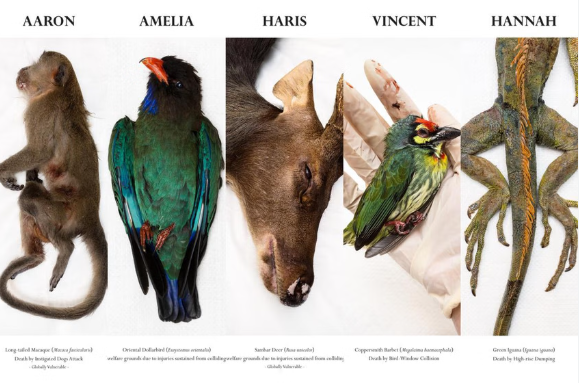A photography exhibition explores the impacts of human activity on wildlife through portraits of dead animals.
Capturing the Lives and Losses of Singapore’s Wildlife
Amid Singapore’s urban sprawl, wildlife such as otters, macaques, and monitor lizards have found their place within the city’s ecosystem. However, with urbanisation on the rise, it’s becoming increasingly difficult for humans and wildlife to coexist peacefully.
The Death By Man photography exhibition, which opened on November 10, aims to shed light on the morbid consequences of human development on wildlife. Through portraits of dead animals, the exhibition tells the stories of these creatures, offering a poignant reflection on the man-made causes of their demise. The exhibition will run until April 2024 at the Lee Kong Chian Natural History Museum.
Photographer Jasvic Lye’s Unique Approach
Photographer Jasvic Lye has been documenting these animals for years, giving each one a human name to make them more relatable to viewers. Her aim is to raise awareness about the struggles wildlife faces in Singapore. Lye, 31, works as a campaign manager for Our Wild Neighbours, an initiative focused on encouraging peaceful coexistence with native wildlife.
The project began in 2017 as part of her Fine Arts degree in Photography and Digital Imaging at Nanyang Technological University. Lye worked alongside wildlife conservation groups such as ACRES and Mandai Wildlife Group to photograph animals that had died due to human activity.
“I wanted to cover a local issue that has yet to be communicated to the masses. People often overlook the reality and threat that wildlife faces due to the city’s green image,” Lye said.
The Animals Featured in the Exhibition
The exhibition highlights various animals whose lives were cut short due to human-wildlife conflict.
Long-tailed macaques are the only monkey species commonly found in Singapore, and while their numbers are healthy here, they are endangered elsewhere. These primates face significant challenges in the city’s urbanized environment.
Coppersmith barbets are another key feature of the exhibition. Known for their distinctive “tonk-tonk-tonk” call, these birds are commonly found in Singapore. One of the barbets featured in the exhibition died in 2015, preserved for research purposes at the National University of Singapore.
Sambar deer, weighing up to 120 kg, have made a recent comeback in Singapore after being nearly wiped out by hunting and deforestation. One deer featured in the exhibition suffered severe injuries from a road accident and was euthanized after causing a crash on the Bukit Timah Expressway.
Green iguanas, a species native to Mexico and Brazil, are also included. In this case, the iguana was intentionally killed after being thrown from a flat. The iguana’s presence in Singapore likely stems from the exotic pet trade.
Oriental dollarbirds, easily identified by the silver-like spots on their wings, were also featured. One bird, named Amelia, was found alive but with a broken neck, and unfortunately had to be euthanized.
Reflecting on the Emotional Journey
For Lye, this exhibition has been an emotional journey, especially when she witnessed the euthanasia of Amelia the bird. “Watching the life fade from her eyes made me realise how different it is to work with the dead and the dying. This was one of my most emotional shoots,” Lye reflected.
Raising Awareness and Fostering Compassion
Through these animal portraits, Lye hopes to spark a greater understanding of the challenges wildlife faces in the modern urban environment. The exhibition serves as both a memorial for the animals and a call to action, urging society to reflect on the consequences of urbanisation and work towards coexistence with nature.


